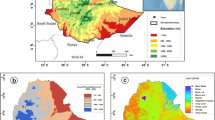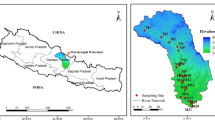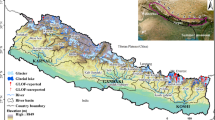Abstract
At the end of the 20th—early twenty-first century, mountain glaciers exhibited the most negative mass balances since the beginning of observations. The hydrological consequence of deglaciation is a rise in glacial runoff until a maximum (‘peak water’) is reached, beyond which runoff decreases as glacier extents are reduced. It is likely that the peak water of glacial runoff has already been passed in the central North Caucasus. River basins with more than 1% glacier cover show consistent decreases in mean monthly discharge in July and August (up to 4–6% per decade during 1945–2018), when glacier meltwater contribution to river runoff is high. Meanwhile, in neighbouring non-glacierised basins, runoff in July and August mostly rose. The runoff in June, when glaciers are typically mostly covered by seasonal snowpack, has increased by 2–9% at most gauges. Hydrological data from the Djankuat alpine research catchment in the central North Caucasus indicate a reduction of glacial runoff contribution in recent decades, as the area reduction of Djankuat glacier and increase in debris cover compensate for the increase in glacier melt. The Djankuat river runoff decreased by 29% in July, 42% in August, and 26% in September in 2007–2020 compared with 1968–1978. The mean annual peak discharge has dropped by 1–5% per decade in the central North Caucasus, and it occurs 1–2 weeks earlier. Possible mechanisms of observed changes are discussed. This study provides the data on climate-related changes in the glacial runoff for a previously not investigated region.




Similar content being viewed by others
References
Baraer M, Mark BG, Mckenzie JM, Condom T, Bury J, Huh K-I et al (2012) Glacier recession and water resources in Peru’s Cordillera Blanca. J Glaciol 58(207):134–150. https://doi.org/10.3189/2012JoG11J186
Bard A, Renard B, Lang M, Giuntoli I, Korck J, Koboltschnig G et al (2015) Trends in the hydrologic regime of Alpine rivers. J Hydrol 529:1823–1837. https://doi.org/10.1016/J.JHYDROL.2015.07.052
Barry RG (1992) Mountain climatology and past and potential future climatic changes in mountain regions: a review. Mt Res Dev 12(1):71–86. https://doi.org/10.2307/3673749
Bliss A, Hock R, Radic V (2013) Journal of Geophysical Research: earth surface century climate change. J Geophys Res:1–14. https://doi.org/10.1002/2013JF002931.Received
Bliss A, Hock R, Radić V (2014) Global response of glacier runoff to twenty-first century climate change. J Geophys Res Earth Surf 119(4):717–730. https://doi.org/10.1002/2013JF002931
Bobrovitskaya NN, Kokorev AV (2014) Current problems of hydrological networks design and optimization, background material for the fourteenth session of the Commission for Hydrology (CHy-14), Geneva, Switzerland. http://www.wmo.int/pages/prog/hwrp/chy/chy14/documents/ms/Network_OptimizationV1.pdf
Bochin NA, Krenke AN (eds) (1980) Observational data on mountain-glacier basins of the Soviet Union under the International Hydrological Decade program. Vol. 1. Gidrometeoizdat, Leningrad
Bochin NA, Krenke AN (eds) (1987) Observational data on Mountain-glacier basins of the Soviet Union under the International Hydrological Decade program. Vol. 2. Gidrometeoizdat, Leningrad
Boyarsky IY (1978) Lednik Djankuat [Djankuat Glacier] (Ed.). Gidrometeoizdat, Saint Petersburg
Bozhinskiy A, Krass M, Popovnin V (1986) Role of debris cover in the thermal physics of glaciers. J Glaciol 32(111):255–266. https://doi.org/10.3189/S0022143000015598
Carey M, Molden OC, Rasmussen MB, Nolin AW, Jackson M, Mark BG (2017) Impacts of glacier recession and declining meltwater on mountain societies. Ann Am Assoc Geogr 107(2):350–359. https://doi.org/10.1080/24694452.2016.1243039
Casassa G, Lopez P, Pouyaud B, Escobar F (2009) Detection of changes in glacial run-off in alpine basins: examples from North America, the Alps, central Asia and the Andes. Hydrol Process 23:31–41. https://doi.org/10.1002/hyp
Chen Y, Li W, Deng H, Fang G, Li Z (2016) Changes in central Asia’s water tower: past, present and future. Sci Rep 6(1):35458. https://doi.org/10.1038/srep35458
Chernokulsky AV, Kozlov FA, Zolina OG, Bulygina ON, Mokhov II, Semenov VA (2019) Observed changes in convective and stratiform precipitation in Northern Eurasia over the last five decades. Environ Res Let 4(4):045001. https://doi.org/10.1088/1748-9326/aafb82
Collins DN (2008) Climatic warming, glacier recession and runoff from Alpine basins after the Little Ice Age Maximum. Ann Glaciol 48:119–124
Duethmann D, Bolch T, Farinotti D, Kriegel D, Vorogushyn S, Merz B et al (2015) Attribution of streamflow trends in snow and glacier melt-dominated catchments of the Tarim River, Central Asia. Water Resour Res 51(6):4727–4750. https://doi.org/10.1002/2014WR016716
Dyurgerov M (2003) Mountain and subpolar glaciers show an increase in sensitivity to climate warming and intensification of the water cycle. J Hydrol 282(1–4):164–176. https://doi.org/10.1016/S0022-1694(03)00254-3
Faleev MI, Chernykh GS, Starostin AS (2014) Otsenka opasnostej I ugroz, obuslovlennykh katastroficheskimi navodnenijami, i predlozhenija po zashite naselenija i territorij ot nikh [Evaluation of hazards a threats Caused by catastrophic floods, and measures for population and land protection]. Strategija grazhdanskoj zashity:problem I issledovanija 4(2(7)):18–32
Farinotti D, Pistocchi A, Huss M (2016) From dwindling ice to headwater lakes: could dams replace glaciers in the European Alps? Environ Res Lett 11(5):054022. https://doi.org/10.1088/1748-9326/11/5/054022
Frolova NL, Kireeva MB, Magritсkiy DV, Bolgov MB, Kopylov VN, Hall J, Semenov VA, Kosolapov AE, Dorozhkin EV, Korobkina EA, Rets EP, Akutina Y, Dzhamalov RG, Efremova NA, Sazonov AA, Agafonova SA, Belyakova PA (2017) Hydrological hazards in Russia: origin, classification, changes and risk assessment. Nat Hazards 88(1):103–131
GLIMS and NSIDC (2005, updated 2018) Global land ice measurements from space glacier database. Compiled and made available by the international GLIMS community and the National Snow and Ice Data Center, Boulder. https://doi.org/10.7265/N5V98602
Golovleva AI (1980) Dinamika khimicheskogo sostava vod gorno-lednikovogo bassejna Djankuat [dynamics of chemical composition of Djankuat mountain-glacier basin]. Unpublished manuscript, Bachelor’s thesis, Lomonosov Moscow State University, Faculty of Geography, Department of Hydrology, Moscow
Hagg W, Shahgedanova M, Mayer, C, Lambrecht A, Popovnin V (2010) A sensitivity study for water availability in the Northern Caucasus based on climate projections. Glob Planet Change 73(3–4):161–171
Han T, Ding Y, Xie C, Ye B, Shen Y, Jiao K (2007) Analysis on the facts of runoff increase in the Urumqi River basin, China. In: Ginot P, Sicart J (eds) Glacier mass balance changes and meltwater discharge (selected papers from sessions at the IAHS Assembly in Foz do Iguacu, Brazil, 2005). IAHS Publication 318: Wallingford, UK, 86–94. https://core.ac.uk/download/pdf/39840939.pdf#page=96
Huss M, Fischer M (2016) Sensitivity of very small glaciers in the Swiss Alps to future climate change. Front Earth Sci 4:34. https://doi.org/10.3389/feart.2016.00034
Huss M, Hock R (2018) Global-scale hydrological response to future glacier mass loss. Nat Clim Chang 8(2):135–140. https://doi.org/10.1038/s41558-017-0049-x
Kireeva M, Frolova N, Rets E, Samsonov T, Entin A, Kharlamov M, Telegina E, Povalishnikova E (2019) Evaluating climate and water regime transformation in the European part of Russia using observation and reanalysis data for the 1945-2015 period. Int J River Basin Manag 1–12. https://doi.org/10.1080/15715124.2019.1695258
Korovin VI, Galkin GA (1979) Geneticheskaja struktura navodnenij i pavodkov na rekah severo-zapadnogo Kavkaza za 275-letnij period [Genetic structure of floods and flash-floods in the Western North Caucausus during 275 years]. Izvestija Acadenii Nauk of USSR Geogr Ser 3:90–94
Kriegel D, Mayer C, Hagg W, Duethmann D, Gafurov A, Farinotti D (2013) Changes in glacierisation, climate and runoff in the second half of the 20th century in the Naryn basin, Central Asia. Glob Planet Chang 110:51–61. https://doi.org/10.1016/J.GLOPLACHA.2013.05.014
Mastakova NR (1978) Formirovanije khimicheskogo stoka vodotokov gorno-lednikovogo bassejna Djankuat [Formation of chemical runoff in Djankuat mountain-glacier basin]. Unpublished manuscript, Master’s thesis, Lomonosov Moscow State University, Faculty of Geography, Department of Hydrology, Moscow
O’Neel S, Hood E, Arendt A, Sass L (2014) Assessing streamflow sensitivity to variations in glacier mass balance. Clim Chang 123(2):329–341. https://doi.org/10.1007/s10584-013-1042-7
Pellicciotti F, Burlando P, Van Vliet K (2007) Recent trends in precipitation and streamflow in the Aconcagua River basin, Central Chile. In: Ginot P, Sicart J (eds) Glacier mass balance changes and meltwater discharge (selected papers from sessions at the IAHS Assembly in Foz do Iguacu, Brazil, 2005). IAHS Publication 318: Wallingford, UK, 17–38. https://core.ac.uk/download/pdf/39840939.pdf#page=27
Pomeroy J, Bernhardt M, Marks D (2015) Research network to track alpine water. Nature 521(7550):32–32. https://doi.org/10.1038/521032c
Popovnin VV, Naruse R (2005) A 34-year-long record of mass balance and geometric changes of the Djankuat Glacier, Caucasus. Bull Glaciol Res 22:121–133
Popovnin VV, Rezepkin AA, Tielidze LG (2015) Superficial moraine expansion on the Djankuat glacier snout over the direct glaciological monitoring period. Kriosfera Zemli 19(1):79–87
Pritchard HD (2019) Asia’s shrinking glaciers protect large populations from drought stress. Nature 569(7758):649–654
Rets E, Kireeva M (2010) Hazardous hydrological processes in mountainous areas under the impact of recent climate change: case study of Terek River basin. Glob Chang 340:126–134
Rets E, Chizhova JN, Loshakova N, Tokarev I, Kireeva MB, Budantseva NA, Vasil’chuk YK, Frolova N, Popovnin V, Toropov P, Terskaya E, Smirnov AM, Belozerov E, Karashova M (2017) Using isotope methods to study alpine headwater regions in the northern Caucasus and Tien Shan. Front Earth Sci 11(3):531–543. https://doi.org/10.1007/s11707-017-0668-6
Rets EP, Dzhamalov RG, Kireeva MB, Frolova NL, Durmanov IN, Telegina AA, Telegina EA, Grigoriev VY (2018) Recent trends of river runoff in the North Caucasus. Geogr Environ Sustain 11(3):61–70. https://doi.org/10.24057/2071-9388-2018-11-3-61-70
Rets EP, Durmanov IN, Kireeva MB (2019a) Peak runoff in the North Caucasus: recent trends in magnitude. Var Timing Water Resour 46:S56–S66. https://doi.org/10.1134/S0097807819070157
Rets EP, Popovnin VV, Toropov PA, Smirnov AM, Tokarev IV, Chizhova J, Budantseva N, Vasil’chuk NA, Yu K, Kireeva MB, Ekaykin AA, Veres AN, Aleynikov AA, Frolova NL, Tsyplenkov AS, Poliukhov AA, Chalov SR, Aleshina MA, Kornilova ED (2019b) Djankuat Glacier Station in the North Caucasus, Russia: a database of glaciological, hydrological, meteorological observations and stable isotopes sampling results during 2007-2017. Earth Syst Sci Data 11:1463–1481. https://doi.org/10.5194/essd-11-1463-2019
Reznichenko N, Davies T, Shulmeister J, Mcsaveney M (2010) Effects of debris on ice-surface melting rates: an experimental study. J Glaciol 56(197):384–194
Shahgedanova M, Stokes CR, Gurney SD, Popovnin VV (2005) Interactions between mass balance, atmospheric circulation and recent climate change on the Djankuat glacier, Caucasus Mountains. J Geophys Res 110(D4):D04108. https://doi.org/10.1029/2004JD005213
Shahgedanova M, Nosenko G, Kutuzov S, Rototaeva O, Khromova T (2014) Deglaciation of the Caucasus Mountains, Russia/Georgia, in the 21st century observed with ASTER satellite imagery and aerial photography. Cryosphere 8:2367–2379. https://doi.org/10.5194/tc-8-2367-2014
Sorg A, Bolch T, Stoffel M, Solomina O, Beniston M (2012) Climate change impacts on glaciers and runoff in Tien Shan (Central Asia). Nat Clim Chang 2(10):725–731. https://doi.org/10.1038/nclimate1592
Sorg A, Huss M, Rohrer M, Stoffel M (2014) The days of plenty might soon be over in glacierized Central Asian catchments. Environ Res Lett 9(10):104018. https://doi.org/10.1088/1748-9326/9/10/104018
Stahl K, Moore RD (2006) Influence of watershed glacier coverage on summer streamflow in British Columbia, Canada. Water Resour Res 42(6). https://doi.org/10.1029/2006WR005022
Tielidze LG, Wheate RD (2018) The greater Caucasus glacier inventory (Russia, Georgia and Azerbaijan). Cryosphere 12(1):81–94
Toropov PA, Aleshina MA, Grachev AM (2019) Large-scale climatic factors driving glacier recession in the Greater Caucasus, 20th–21st century. Int J Climatol 39(12):4703–4720
Viviroli D, Dürr HH, Messerli B, Meybeck M, Weingartner R (2007) Mountains of the world, water towers for humanity: typology, mapping, and global significance. Water Resour Res 43(7):1–13. https://doi.org/10.1029/2006WR005653
Viviroli D, Archer DR, Buytaert W, Fowler HJ, Greenwood GB, Hamlet AF et al (2011) Climate change and mountain water resources: overview and recommendations for research, management and policy. Hydrol Earth Syst Sci 15(2):471–504. https://doi.org/10.5194/hess-15-471-2011
WGMS (2019) Fluctuations of glaciers database. World Glacier Monitoring Service, Zurich. https://doi.org/10.5904/wgms-fog-2019-12
WMO (1974) International glossary of hydrology. WMO: World Meterological Organisation, Geneva
Ye B, Yang D, Jiao K, Han T, Jin Z, Yang H, Li Z (2005) The Urumqi River source Glacier No. 1, Tianshan, China: changes over the past 45 years. Geophys Res Lett 32(21):L21504. https://doi.org/10.1029/2005GL024178
Zemp M, Frey H, Gärtner-Roer I, Nussbaumer SU, Hoelzle M, Paul F et al (2015) Historically unprecedented global glacier decline in the early 21st century. J Glaciol 61(228):745–762. https://doi.org/10.3189/2015JoG15J017
Acknowledgements
This work was supported by the Russian Science Foundation (project no. 17-77-10169—for the calculation and analysis of peak runoff and water availability during the vegetation period), the Grant of the President of the Russian Federation for young scientists MK-2936.2019.5 for processing hydrological observational data from the Djankuat research basin, and by the Russian Foundation for Basic Research 18-05-00420—for Djankuat glacier mass balance analysis. The authors would like to thank Maya B. Zaslavskaya for help with obtaining the archive observational data for the Djankuat research basin.
Data availability statement
The data from the Djankuat research basin for the recent period of observation, 2007–2017, that support the findings of this study are openly available in Pangaea at https://doi.org/10.1594/PANGAEA.894807.
The archive hydrological data (1968–1978) was obtained from manuscripts (Bochin and Krenke 1980; Bochin and Krenke 1987; Golovleva 1980; Mastakova 1978).
The hydrological data from the hydrological station of the Russian Hydrometeorological State Service is available from the official editions of the Russian Hydrometeorological State Service.
Author information
Authors and Affiliations
Corresponding author
Additional information
Publisher’s note
Springer Nature remains neutral with regard to jurisdictional claims in published maps and institutional affiliations.
Supplementary Information
ESM 1
(DOCX 9587 kb)
Rights and permissions
About this article
Cite this article
Rets, E.P., Durmanov, I.N., Kireeva, M.B. et al. Past ‘peak water’ in the North Caucasus: deglaciation drives a reduction in glacial runoff impacting summer river runoff and peak discharges. Climatic Change 163, 2135–2151 (2020). https://doi.org/10.1007/s10584-020-02931-y
Received:
Accepted:
Published:
Issue Date:
DOI: https://doi.org/10.1007/s10584-020-02931-y




